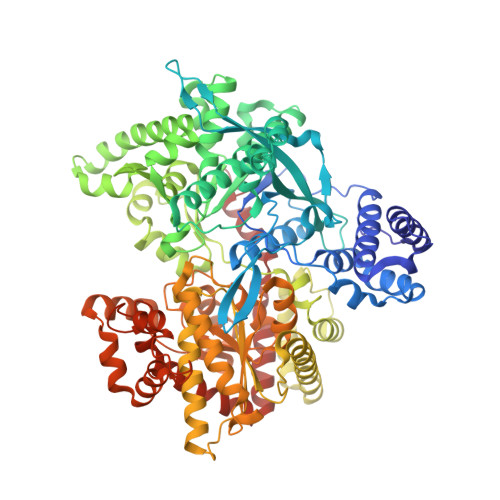X-ray studies on ternary complexes of maltodextrin phosphorylase.
Campagnolo, M., Campa, C., Zorzi, R.D., Wuerges, J., Geremia, S.(2008) Arch Biochem Biophys 471: 11-19
- PubMed: 18164678
- DOI: https://doi.org/10.1016/j.abb.2007.11.023
- Primary Citation of Related Structures:
2AV6, 2AW3, 2AZD - PubMed Abstract:
We report crystal structures of ternary complexes of maltodextrin phosphorylase with natural oligosaccharide and phosphate mimicking anions: nitrate, sulphate and vanadate. Electron density maps obtained from crystals grown in presence of Al(NO3)3 show a nitrate ion instead of the expected AlF4- in the catalytic site. The trigonal NO3- is coplanar with the Arg569 guanidinium group and mimics three of the four oxygen atoms of phosphate. The ternary complex with sulphate shows a partial occupancy of the anionic site. The low affinity of the sulphate ion, observed when the alpha-glucosyl substrate is present in the catalytic channel, is ascribed to restricted space for the anion. Even lower occupancy is observed for the larger vanadate anion. The Malp/G5/VO43- structure shows the partial occupancy of the oligosaccharide and the dislocation of the 380's loop. This has been attributed to the formation of oligosaccharide vanadate derivatives (confirmed by capillary electrophoresis) that reduces their effective concentration. The difficulty to trap a ternary complex mimicking the ground state has been correlated to the apparent lower affinity that natural substrates show regarding the intermediates of the enzymatic reaction.
Organizational Affiliation:
CEB-Centre of Excellence in Biocrystallography, Department of Chemical Sciences, University of Trieste, via L. Giorgieri 1, 34127 Trieste, Italy.

















